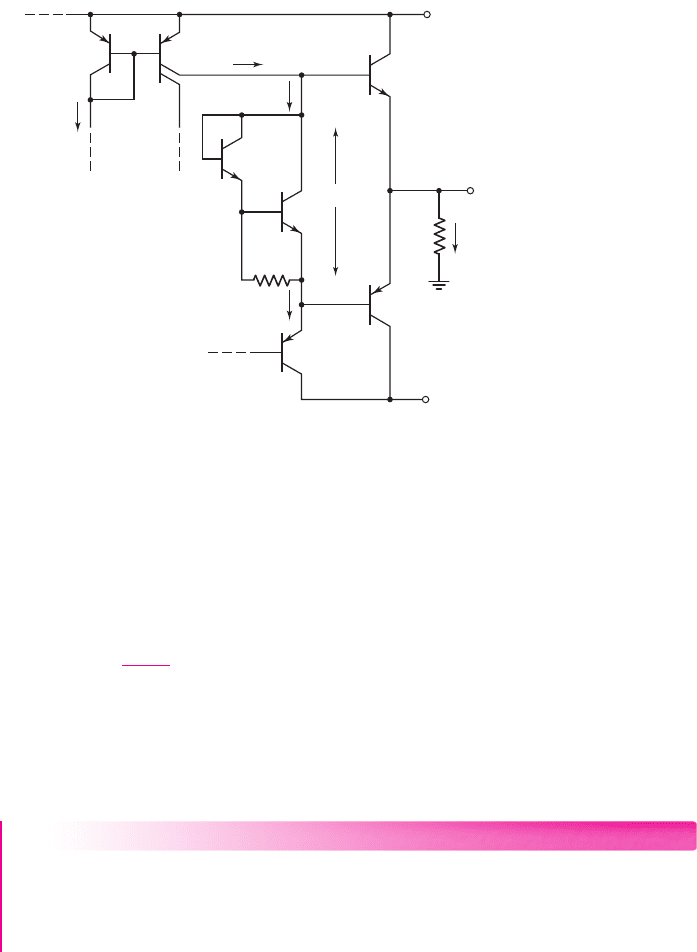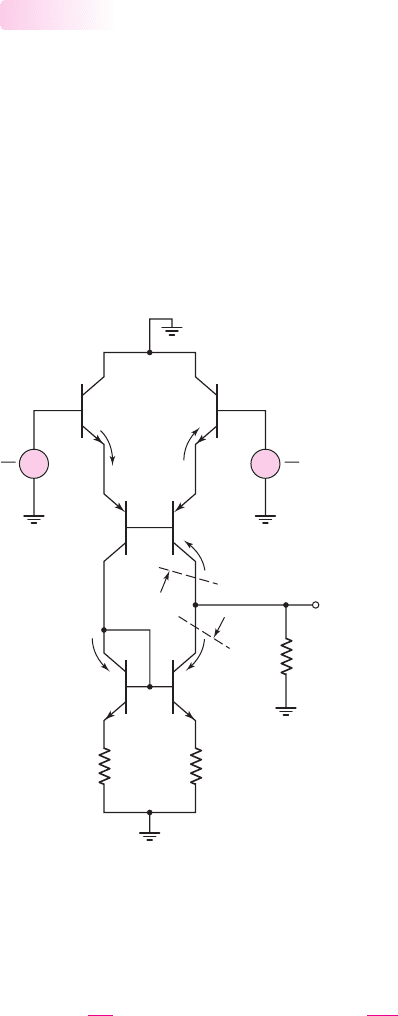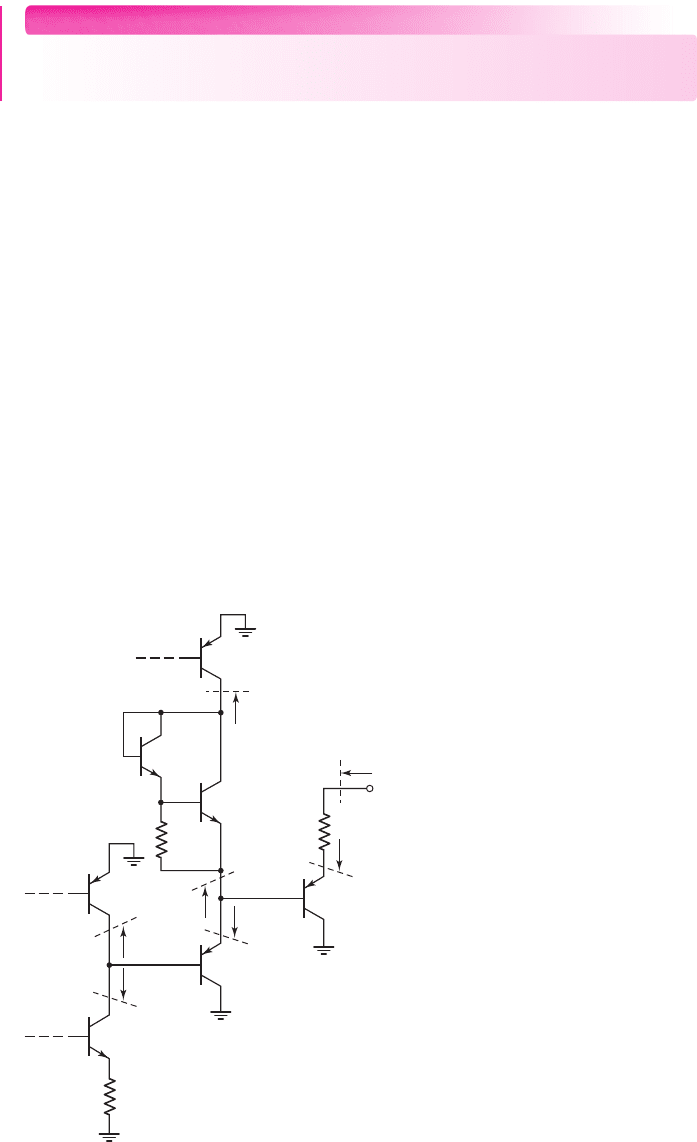Neamen D. Microelectronics: Circuit Analysis and Design
Подождите немного. Документ загружается.


Output Stage
Figure 13.8 shows the basic output stage of the 741 op-amp. This is a class-AB con-
figuration, discussed in Chapter 8. The I
Bias
is supplied by Q
13A
, and the input signal
is applied to the base of Q
22
, which operates as an emitter follower. The combination
of Q
18
and Q
19
establishes two B–E voltage drops between the base terminals of Q
14
and Q
20
, causing the output transistors to be biased slightly in the conducting state.
This
V
BB
voltage produces quiescent collector currents in Q
14
and Q
20
. Biasing both
Q
14
and Q
20
“on” with no signal present at the input ensures that the output stage will
respond linearly when a signal is applied to the op-amp input.
958 Part 2 Analog Electronics
V
+
Q
14
Q
19
R
10
=
50 kΩ
Q
18
Q
20
Q
12
Q
13A
Q
13B
Q
22
R
L
v
I
v
O
V
–
I
C13A
i
L
I
Bias
I
Bias
I
REF
V
BB
+
–
Figure 13.8 Basic output stage, 741 op-amp, showing currents and voltages
The collector of Q
13A
has a scale factor of 0.25 times that of Q
12
. Neglecting base
currents, current I
C13A
is
I
C13A
= 0.25I
REF
= I
Bias
(13.10)
where I
REF
is given by Equation (13.1). Neglecting base currents, the collector
current in Q
22
is also equal to I
Bias
. The collector current in Q
18
is
I
C18
∼
=
V
BE19
R
10
(13.11)
Therefore,
I
C19
= I
Bias
− I
C18
(13.12)
EXAMPLE 13.3
Objective: Calculate the bias currents in the output stage of the 741 op-amp.
Consider the output stage shown in Figure 13.8. Assume the reverse saturation
currents of Q
18
and Q
19
are
I
S
= 10
−14
A, and the reverse saturation currents of Q
14
and Q
20
are
I
S
= 3 ×10
−14
A
. Neglect base currents.
nea80644_ch13_947-1008.qxd 6/23/09 1:59 PM Page 958 pmath DATA-DISK:Desktop Folder:23/06/09:MHDQ134-13:

Solution: The reference current, from Example 13.1, is
I
REF
= 0.72
mA. Current
I
C13A
is then
I
C13A
= (0.25)I
REF
= (0.25)(0.72) = 0.18 mA
∼
=
I
Bias
If we assume
V
BE19
= 0.6
V, then the current in R
10
is
I
R10
=
V
BE19
R
10
=
0.6
50
= 0.012 mA
The current in Q
19
is
I
C19
∼
=
I
E19
= I
C13A
− I
R10
= 0.18 −0.012 = 0.168 mA
For this value of collector current, the B–E voltage of Q
19
is
V
BE19
= V
T
ln
I
C19
I
S
= (0.026) ln
0.168 × 10
−3
10
−14
= 0.612 V
which is close to the assumed value of 0.6 V. Assuming
β
n
= 200
for the npn
devices, the base current in Q
19
is
I
B19
=
I
C19
β
n
=
168 μA
200
= 0.84 μA
The current in Q
18
is now
I
C18
∼
=
I
E18
= I
R10
+ I
B19
= 12 +0.84 = 12.84 μA
The B–E voltage of Q
18
is therefore
V
BE18
= V
T
ln
I
C18
I
S
= (0.026) ln
12.84 × 10
−6
10
−14
= 0.545 V
The voltage difference
V
BB
is thus
V
BB
= V
BE18
+ V
BE19
= 0.545 +0.612 = 1.157 V
Since the output transistors Q
14
and Q
20
are identical, one-half of V
BB
is across each
B–E junction. The quiescent currents in Q
14
and Q
20
are
I
C14
= I
C20
= I
S
e
(V
BB
/2)/V
T
= 3 ×10
−14
e
(1.157/2)/0.026
or
I
C14
= I
C20
= 138 μA
Comment: Using the piecewise linear approximation of 0.6 V for the B–E junction
voltage does not allow us to determine the quiescent currents in Q
14
and Q
20
. For a
more accurate analysis, the exponential relationship must be used, since the base–
emitter areas of the output transistors are larger than those of the other transistors, and
because the output transistors are biased at a low quiescent current.
EXERCISE PROBLEM
Ex 13.3: Calculate the bias currents
I
C13A
,
I
R10
,
I
C19
,
I
C18
, and
I
C14
in the output
stage of the 741 op-amp for
I
REF
= 0.50
mA,
V
+
= 5
V, and
V
−
=−5
V. All
other parameters are the same as described in Example 13.3. (Ans.
I
C13A
=
0.125
mA,
I
R10
= 0.012
mA,
I
C19
= 0.113
mA,
I
C18
= 12.565 μ
A,
I
C14
=
0.113
mA)
Chapter 13 Operational Amplifier Circuits 959
nea80644_ch13_947-1008.qxd 6/23/09 1:59 PM Page 959 pmath DATA-DISK:Desktop Folder:23/06/09:MHDQ134-13:

As the input signal
v
I
increases, the base voltage of Q
14
increases since the
V
BB
voltage remains almost constant. The output voltage increases at approximately the
same rate as the input signal. As
v
I
decreases, the base voltage of Q
20
decreases, and
the output voltage also decreases, again at approximately the same rate as the input
signal. The small-signal voltage gain of the output stage is essentially unity.
Short-Circuit Protection Circuitry
The output stage includes a number of transistors that are off during the normal
operation of the amplifier. If the output terminal is at a positive voltage because of an
applied input signal, and if the terminal is inadvertently shorted to ground potential,
a large current will be induced in output transistor Q
14
. A large current can produce
sufficient heating to cause transistor burnout.
The complete output stage of the 741, including the short-circuit protection
devices, is shown in Figure 13.9. Resistor R
6
and transistor Q
15
limit the current in Q
14
in the event of a short circuit. If the current in Q
14
reaches 20 mA, the voltage drop
across R
6
is 540 mV, which is sufficient to bias Q
15
in the conducting stage. As Q
15
turns on, excess base current into Q
14
is shunted through the collector of Q
15
. The base
current into Q
14
is then limited to a maximum value, which limits the collector current.
960 Part 2 Analog Electronics
Q
13A
V
–
V
+
R
11
=
50 kΩ
R
6
=
27 Ω
Q
14
Q
19
R
7
=
22 Ω
R
10
=
50 kΩ
Q
18
Q
24
Q
15
Q
22
R
L
v
O
Q
21
Q
20
I
C13A
v
I3
Figure 13.9 Output stage, 741 op-amp with short-circuit protection devices
The maximum current in Q
20
is limited by components R
7
, Q
21
, and Q
24
, in much
the same way as just discussed. A large output current will result in a voltage drop
across R
7
, which will be sufficient to bias Q
21
in its conducting state. Transistors Q
21
and Q
24
will shunt excessive output current away from Q
20
, to protect this output
transistor.
nea80644_ch13_947-1008.qxd 6/23/09 1:59 PM Page 960 pmath DATA-DISK:Desktop Folder:23/06/09:MHDQ134-13:

Small-Signal Analysis
We can analyze the small-signal voltage gain of the 741 op-amp by dividing it into
its basic circuits and using results previously obtained.
Input Stage
Figure 13.10 shows the ac equivalent circuit of the input stage with a differential
voltage
v
d
applied between the input terminals. The constant-current biasing at the
base of Q
3
and Q
4
means that the effective impedance connected to the base terminal
of Q
3
and Q
4
is ideally infinite, or an open circuit. Resistance R
act1
is the effective
resistance of the active load and R
i2
is the input resistance of the gain stage.
13.2.3
Chapter 13 Operational Amplifier Circuits 961
+
–
–
+
Q
1
i
e1
i
e2
r
o4
R
act1
i
e2
i
e1
R
i2
v
o1
i
e1
Q
2
Q
3
R
1
R
2
Q
4
Q
5
Q
6
v
d
2
v
d
2
Figure 13.10 Simplified ac equivalent circuit of input stage of 741 op-amp
From the results in Chapter 11, the small-signal differential voltage gain can be
written as
A
d
=
v
o1
v
d
=−g
m
(r
o4
R
act1
R
i2
) =−
I
CQ
V
T
(r
o4
R
act1
R
i2
)
(13.13)
where I
CQ
is the quiescent collector current in each of the transistors Q
1
through Q
4
,
and r
o4
is the small-signal output resistance looking into the collector of Q
4
. Using r
o4
as the resistance looking into the collector of Q
4
neglects the effective resistance in the
emitter of Q
4
. This effective resistance is simply the resistance looking into the emit-
ter of Q
2
, which is normally very small. The minus sign in the voltage gain expression
results from the applied signal voltage polarity and resulting current directions.
nea80644_ch13_947-1008.qxd 6/23/09 1:59 PM Page 961 pmath DATA-DISK:Desktop Folder:23/06/09:MHDQ134-13:

The effective resistance of the active load is given by
R
act1
= r
o6
[
1 + g
m6
(R
2
r
π6
)
]
(13.14)
as determined in Chapter 10 for the output resistance of a Widlar current source.
From Figure 13.7, the input resistance of the gain stage is
R
i2
= r
π16
+(1 +β
n
)R
E
(13.15)
where
R
E
is the effective resistance in the emitter of Q
16
, as given by
R
E
= R
9
[
r
π17
+(1 +β
n
)R
8
]
(13.16)
EXAMPLE 13.4
Objective: Determine the small-signal differential voltage gain of the 741 op-amp
input stage.
Assume npn transistor gains of
β
n
= 200
and Early voltages of
V
A
= 50
V.
Solution: The quiescent collector currents were determined previously in this chap-
ter. The input resistance to the gain stage is found from Equations (13.15) and
(13.16), as follows:
r
π17
=
β
n
V
T
I
C17
=
(200)(0.026)
0.54
= 9.63 k
Therefore,
R
E
= R
9
[r
π17
+(1 +β
n
)R
8
] = 50[9.63 +(201)(0.1)] = 18.6k
Also,
r
π16
=
β
n
V
T
I
C16
=
(200)(0.026)
0.0158
= 329 k
Consequently,
R
i2
= r
π16
+(1 +β
n
)R
E
= 329 +(201)(18.6) ⇒ 4.07 M
The resistance of the active load is determined from Equation (13.14). We find
r
π6
=
β
n
V
T
I
C6
=
(200)(0.026)
0.0095
= 547 k
g
m6
=
I
C6
V
T
=
0.0095
0.026
= 0.365
mA/V
and
r
o6
=
V
A
I
C6
=
50
0.0095
⇒ 5.26 M
Then,
R
act1
= r
o6
[
1 + g
m6
(R
2
r
π6
)
]
= 5.26
[
1 + (0.365)(1547)
]
= 7.18 M
Resistance r
o4
is
r
o4
=
V
A
I
C4
=
(50)
(0.0095)
⇒ 5.26 M
962 Part 2 Analog Electronics
nea80644_ch13_947-1008.qxd 6/23/09 1:59 PM Page 962 pmath DATA-DISK:Desktop Folder:23/06/09:MHDQ134-13:

Finally, from Equation (13.13), the small-signal differential voltage gain is
A
d
=−
I
CQ
V
T
(r
o4
R
act1
R
i2
) =−
9.5
0.026
(5.267.184.07)
or
A
d
=−636
Comment: The relatively large gain results from the use of an active load and the
fact that the gain stage does not drastically load the input stage.
EXERCISE PROBLEM
Ex 13.4: Repeat Example 13.4 assuming Early voltages of
V
A
= 100
V. (Ans.
A
d
=−889
)
Gain Stage
Figure 13.11 shows the ac equivalent circuit of the gain stage. Resistance R
act2
is the
effective resistance of the active load and R
i3
is the input resistance of the output stage.
Chapter 13 Operational Amplifier Circuits 963
R
i3
R
i2
Q
16
Q
17
I
b16
I
b17
R
8
=
0.1 kΩ
R
9
=
50 kΩ
V
o2
V
o1
R
act2
Figure 13.11 The ac equivalent circuit, gain stage of 741 op-amp
We develop the small-signal voltage gain using Figure 13.11 directly. The input
base current to Q
16
is
i
b16
=
v
o1
R
i2
(13.17)
where
R
i2
is the input resistance to the gain stage. The base current into Q
17
is
i
b17
=
R
9
R
9
+
[
r
π17
+(1 +β
n
)R
8
]
×i
e16
(13.18)
where
i
e16
is the emitter current from
Q
16
. The output voltage is
v
o2
=−i
c17
(R
act2
R
i3
R
o17
)
(13.19)
nea80644_ch13_947-1008.qxd 6/23/09 1:59 PM Page 963 pmath DATA-DISK:Desktop Folder:23/06/09:MHDQ134-13:

where
i
c17
is the ac collector current in Q
17
and
R
o17
is the output impedance looking
into the collector of Q
17
. Combining Equations (13.17), (13.18), and (13.19), we get
the following expression for the small-signal voltage gain:
A
v2
=
v
o2
v
o1
=
−β
n
(1 + β
n
)R
9
(R
act2
R
i3
R
o17
)
R
i2
{R
9
+[r
π17
+(1 +β
n
)R
8
]}
(13.20)
The effective resistance of the active load is the resistance looking into the
collector of Q
13B
, or
R
act2
= r
o13B
=
V
A
I
C13B
(13.21)
The input resistance of the output stage can be determined from the ac equiva-
lent circuit in Figure 13.12. In this figure, we assume that the pnp output transistor
Q
20
is active and the npn output transistor Q
14
is cut off. A load resistor R
L
is also
included. Transistor Q
22
operates as an emitter follower, which means that the input
resistance is
R
i3
= r
π22
+(1 +β
p
)[R
19
R
20
]
(13.22)
Resistance R
19
is the series combination of the resistance looking into the emitters of
Q
19
and Q
18
, and the resistance looking into the collector of Q
13A
. The effective
resistance of the combination of Q
18
and Q
19
is small compared to R
13A
; therefore,
R
19
∼
=
R
13A
= r
o13A
=
V
A
I
C13A
(13.23)
The output transistor Q
20
is also an emitter follower; therefore,
R
20
= r
π20
+(1 +β
p
)R
L
(13.24)
where the load resistance
R
L
is assumed to be much larger than R
7
.
964 Part 2 Analog Electronics
R
i3
R
20
Q
13A
R
10
=
50 kΩ
Q
19
R
7
Q
18
Q
22
R
L
V
o
Q
20
V
o2
R
19
R
13A
Figure 13.12 The ac equivalent circuit, 741 op-amp output stage, for calculating input
resistance
nea80644_ch13_947-1008.qxd 6/23/09 1:59 PM Page 964 pmath DATA-DISK:Desktop Folder:23/06/09:MHDQ134-13:

EXAMPLE 13.5
Objective: Determine the small-signal voltage gain of the second stage of the 741
op-amp.
Assume the current gains of the pnp transistors are
β
p
= 50
and the gains of the
npn transistors are
β
n
= 200
. Also assume the Early voltage is 50 V for all transistors
and the load resistance connected to the output is
R
L
= 2k
. The dc quiescent
currents were determined previously.
Solution: First, we calculate the various resistances. To begin,
r
π20
=
β
p
V
T
I
C20
=
(50)(0.026)
0.138
= 9.42 k
which means that
R
20
= r
π20
+(1 +β
p
)R
L
= 9.42 +(51)(2)
∼
=
111 k
Also,
R
19
= r
o13A
=
V
A
I
C13A
=
50
0.18
= 278 k
and
r
π22
=
β
p
V
T
I
C13A
=
(50)(0.026)
0.18
= 7.22 k
The input resistance to the output stage is therefore
R
i3
= r
π22
+(1 +β
p
)[R
19
R
20
] = 7.22 +(51)[278
111] ⇒ 4.05 M
The effective resistance of the active load is
R
act2
=
V
A
I
C13B
=
50
0.54
= 92.6k
and the output resistance
R
o17
is
R
o17
∼
=
V
A
I
C17
=
50
0.54
= 92.6k
This calculation neglects the very small value of R
8
in the emitter.
From Equation (13.20), the small-signal voltage gain is as follows (all resis-
tances are given in kilohms):
A
v2
=
−β
n
(1 + β
n
)R
9
(R
act2
R
i3
R
o17
)
R
i2
{R
9
+[r
π17
+(1 +β
n
)R
8
]}
=
−(200)(201)(50)(92.6405092.6)
4070{50 + [9.63 + (201)(0.1)]}
or
A
v2
=−285
Comment: The voltage gain of the second stage is fairly large, again because an
active load is used and because there is no severe loading effect from the output stage.
Chapter 13 Operational Amplifier Circuits 965
nea80644_ch13_947-1008.qxd 6/23/09 1:59 PM Page 965 pmath DATA-DISK:Desktop Folder:23/06/09:MHDQ134-13:

EXERCISE PROBLEM
Ex 13.5: Repeat Example 13.5 assuming Early voltages of
V
A
= 100
V.
(Ans.
A
2
=−562
)
Overall Gain
In calculating the voltage gain of each stage, we took the loading effect of the
following stage into account. Therefore, the overall voltage gain is the product of the
individual gain factors, or
A
v
= A
d
A
v2
A
v3
(13.25)
where
A
v3
is the voltage gain of the output stage. If we assume that
A
v3
≈ 1
, as pre-
viously discussed, then the overall gain of the 741 op-amp is
A
v
= A
d
A
v2
A
v3
= (−636)(−285)(1) = 181,260
(13.26)
Typical voltage gain values for the 741 op-amp are in the range of 200,000. The
value determined in our calculations illustrates the magnitude of voltage gains that
can be obtained in op-amp circuits.
Output Resistance
The output resistance can be determined by using the ac equivalent circuit in Fig-
ure 13.13. In this case, we assume the output transistor Q
20
is conducting and Q
14
is
cut off. The same basic result is obtained if Q
14
is conducting and Q
20
is cut off.
966 Part 2 Analog Electronics
R
c13B
R
c17
R
e20
R
e22
R
o
Q
13A
Q
19
R
7
=
22 Ω
R
10
R
8
=
100 Ω
Q
18
Q
22
Q
20
R
c19
R
c13A
Q
13B
Q
17
Figure 13.13 The ac equivalent circuit, 741 op-amp output stage, for calculating output
resistance
nea80644_ch13_947-1008.qxd 6/23/09 1:59 PM Page 966 pmath DATA-DISK:Desktop Folder:23/06/09:MHDQ134-13:

We again rely on results obtained previously for output resistances of basic amplifier
stages.
The output resistance is
R
o
= R
7
+ R
e20
(13.27)
where
R
e20
=
r
π20
+ R
e22
R
c19
(1 + β
p
)
(13.28)
Previously we argued that the series resistance due to Q
18
and Q
19
is small compared
to R
c13A
, so that
R
c19
∼
=
R
c13A
. We also have
R
e22
=
r
π22
+ R
c17
R
c13B
(1 + β
p
)
(13.29)
where
R
c13B
= r
o13B
and
R
c17
= r
o17
[1 + g
m17
(R
8
r
π17
)]
The output resistance of the op-amp is then found by combining all the resistance
terms.
EXAMPLE 13.6
Objective: Calculate the output resistance of the 741 op-amp.
Consider the output stage configuration in Figure 13.13. Assume the output cur-
rent is
I
c20
= 2
mA and all other bias currents are as previously determined.
Solution: Using
β
n
= 200
,
β
p
= 50
, and
V
A
= 50
V, we find the following:
r
π17
= 9.63 k r
π22
= 7.22 k r
π20
= 0.65 k
g
m17
= 20.8 mA/V r
o17
= 92.6k r
o13B
= 92.6k
Then,
R
c17
= r
o17
[1 + g
m17
(R
8
r
π17
)] = 92.6[1 +(20.8)(0.19.63)] = 283 k
and
R
e22
=
r
π22
+ R
c17
R
c13B
(1 + β
p
)
=
7.22 + 28392.6
51
= 1.51 k
Also,
R
c19
∼
=
R
c13A
= r
o13A
=
V
A
I
C13A
=
50
0.18
= 278 k
Therefore
R
e20
=
r
π20
+ R
e22
R
c19
(1 + β
p
)
=
0.65 + 1.51278
51
= 0.0422 k ⇒ 42.2
Consequently, the output resistance is
R
o
= R
7
+ R
e20
= 22 +42.2 = 64.2
Chapter 13 Operational Amplifier Circuits 967
nea80644_ch13_947-1008.qxd 6/23/09 1:59 PM Page 967 pmath DATA-DISK:Desktop Folder:23/06/09:MHDQ134-13:
